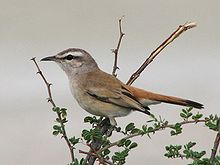- Kalahari Scrub-robin
-
Kalahari Scrub-robin 
Conservation status Scientific classification Kingdom: Animalia Phylum: Chordata Class: Aves Order: Passeriformes Family: Muscicapidae Genus: Cercotrichas Species: E. paena Binomial name Cercotrichas paena
Smith, 1836The Kalahari Scrub-robin (Erythropygia paena) is a species of bird in the Muscicapidae family. It is sometimes known as the Sandy Scrub-robin. It is found in southern Angola, Botswana, Namibia, northern South Africa, and Zimbabwe, where it occurs in sandveld with low trees and scrub, on the edges of woodland, and in savanna. It will also inhabit human-altered environments including old fields and gardens. The species is common and not considered threatened by human activities.
The Kalahari Scrub-robin is a seasonal breeder, with the season stretching from August to February, and peaking in November, also the peak of the wet season.[2] The species is monogamous and territorial, with territory sizes varying from 0.7 - 4.3 ha. Females are responsible for constructing the nest, which are weaved of shrubs and grasses and placed in low thorny bushes. The nest building stage takes around 5 days. The average clutch size is around 2 eggs, although clutch size is bigger later in the season. Only the female incubates the eggs, the male defends the nest, aggressively attacking intruders and warning when predators approach. The incubation lasts around 12 days. Having hatched the female removes the eggshells from the nests and drops them away from the nest to disguise the nest from potential predators. After hatching the female broods the chicks for a between 3–7 days. Both parents help in feeding the chicks and removing the faecal sacks. The chicks are altricial and take around 12 days to fledge.
References
- ^ BirdLife International (2004). Erythropygia paena. 2006 IUCN Red List of Threatened Species. Downloaded on 25 July 2007.
- ^ Engelbrecht, G. Derek (2008). "Breeding biology of the Kalahari Scrub-Robin (Cercotrichas paena) (Muscicapidae)". Emu 108 (4): 293–300. doi:10.1071/MU07078.

This article about an Old World flycatcher is a stub. You can help Wikipedia by expanding it.

